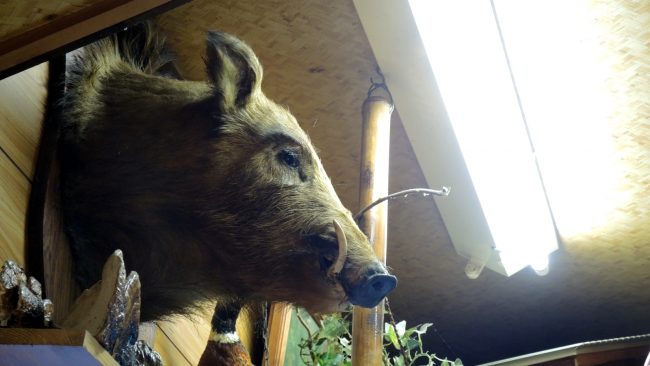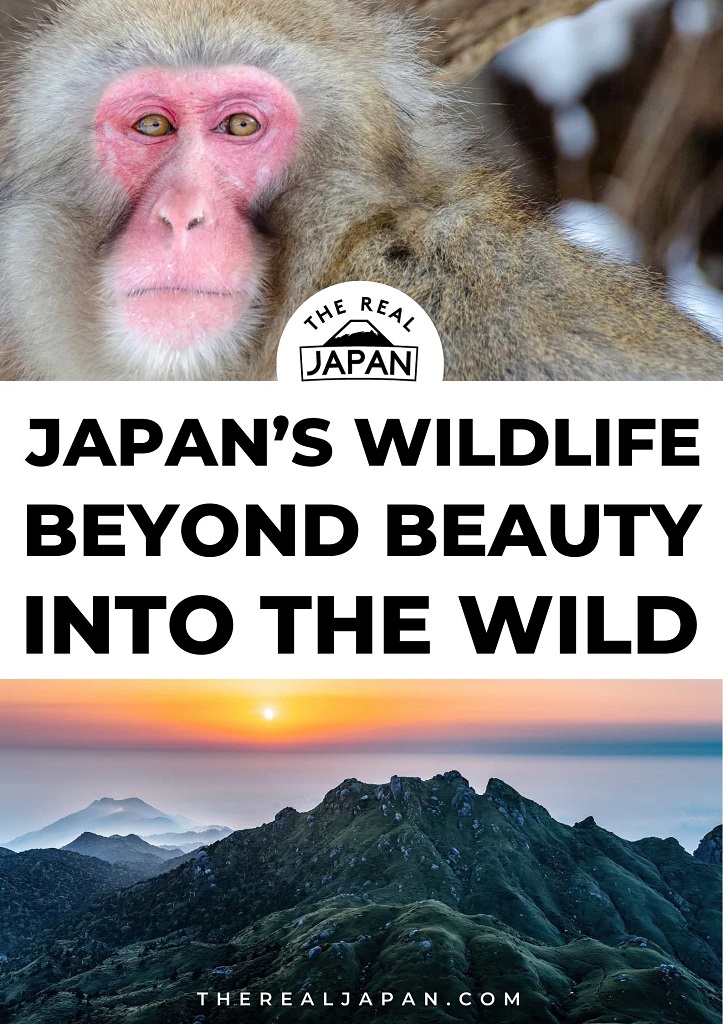Beyond the cliche of Japan's dazzling cities lies a hidden treasure: its diverse wildlife.
From stunning national parks to rare species in lush landscapes, it's a nature lover's paradise. Yet, Japan's wildlife isn't just serene beauty; it has a wilder side, highlighting the delicate balance between human development and natural habitats.
In this guide we'll take a look at Japan's wildlife, unveiling both its beauty and its untamed spirit, and how the country tries to balance progress with preserving its animals and natural heritage.
It includes the Sankebetsu brown bear incident attack of 1915 and my personal encounters with wild boar in Japan...
Get my free Japan Travel Bulletin:
Japan’s Wildlife: Beyond Beauty and Into The Wild
by Rob Dyer
Anyone doing their homework prior to visiting Japan will soon discover the country's natural world and its wildlife is a major attraction. And yet is still often overlooked, particularly by first-time visitors. They may have swiped through photos of Japanese Macaques, aka 'snow monkeys', on social media, but personal encounters with some wilder, even dangerous, larger animals like wild boar or huge brown bears are also possible.
The reality is that Japan is the perfect place for nature lovers who love to see lush landscapes and diverse wildlife. Travellers to Japan have the opportunity to explore stunning national parks, rare species, and nature reserves far away from those neon-lit cities.

Japanese Macaques, aka 'snow monkeys' are one of a number of species found only in Japan
But Japan's wildlife is not just natural beauty; it also has an untamed side that sometimes tests the balance between human development and wild animal habitats.
The Sankebetsu brown bear incident of 1915
The challenges of humans living in harmony alongside animals are not new, nor is it something found only in the pages of ancient history books.
A film released in 2023 called Cocaine Bear about a bear that kills people after eating large amounts of cocaine caused an international stir due to its portrayal of comedy elements contrasting with dark, shocking aspects. The film was inspired by true events and looks into the absurdity and danger of a wild bear encounter, resulting in millions of of people Googling how to survive a cocaine bear attack, how to fight a cocaine bear, and more.

The Ezo (or Ussuri) brown bear in Hokkaido
Even though that was a piece of entertainment inspired by a true story, there is another real life incident that occurred in 1915 in the rural village of Sankebetsu, Hokkaido that left many Japanese shocked by the potential dangers of wildlife encounters. It too was used as the basis for multiple dramatisations. It's known as the 1915 Sankebetsu brown bear incident.
This was a series of bear attacks in a remote area, which took place over one week in December 1915. A starving male Ezo brown bear came down from the mountain, and attacked a number of households, killing seven people and injuring three. The attacks ended when the hungry bear was shot dead.
This became an example of why Japanese authorities needed to set precautions in areas where animals and humans coexist.
The Sankebetsu brown bear incident in popular culture
The Sankebetsu brown bear incident has captured the imagination of many storytellers over the years. Notable adaptations include two Japanese novels: Yukio Togawa's The Bear Wind (1965) and Akira Yoshimura's The Bear Storm (1977), both of which fictionalised the events while maintaining the core of the historical incident.

The 1990 film Yellow Fangs is a dramatisation of the Sankebetsu brown bear incident
In the same year as Togawa's novel, Anthony Perrin published the non-fiction account The Tomamae Bear Incident: The Greatest Tragedy in the History of Animal Attacks (1965), providing a detailed examination of the events for an international audience. The story was further brought to life through Sou Kuramoto's radio play and stage performance, both titled The Bear Storm, in 1980 and 1986 respectively. The incident also found its way into manga with The Wild Legend by Yukio Togawa and Takao Yaguchi.
Perhaps the most high-profile adaptation came in 1990 with the film Yellow Fangs, directed by the renowned action star Sonny Chiba. These varied adaptations demonstrate the lasting fascination with this tragic event, and highlight that maintaining a harmonious balance between humans and wildlife remains an ever present challenge.
My encounters with wild boar in Japan
Wild boar, or innoshishi as the locals call them, remain a common sight in Japan. And not just in the mountain forests. I've encountered wild boar twice in Japan's cities. The first time was in Ashiya City in the spring. I spotted one in a storm drain only a matter of yards away from a group of schoolchildren who were enjoying a barbecue. It was probably drawn by the smell of the cooking food. Thankfully, it was nervous enough to have kept its distance and got no closer, eventually running back into the nearby mountain.
The second time was in Kobe, next to an elevator giving access to the cable car connecting the city to the Nunobiki Herb Garden. The garden is at the northern edge of the city at the base of the the Rokko mountains. One time, when I was waiting for the elevator, I saw something moving out of the corner of my eye. And little more than a few metres in front of me, right up against a wire mesh fence, I saw a wild boar snuffling around the fallen leaves and bamboo looking for food.

The Takinochaya restaurant on Rokko mountain is filled with hunting ephemera
Wild boar are so common in Japan that it is legal to hunt them. A fact made clear to my wife and I when one day out hiking we stumbled across a restaurant filled with wild boar hunting ephemera - also in the Rokko mountains.
Rare species of the Ogasawara Islands
There are numerous examples of the country's commitment to wildlife protection. There are many protected habitats in Japan, with some of them listed as UNESCO World Heritage sites, meaning they keep native species of animals protected.
The Ogasawara Islands (or the 'Galápagos of the East' as they are sometimes called) can be found in the Pacific Ocean, 1,000km off the coast of Tokyo. Because of their isolation, many of their animals and plants have undergone unique evolutionary processes.

The Ogasawara greenfinch is Japan's most endagered bird | Credit: Aaron Maizlish
The Ogasawara Islands (also called the Bonin Islands) include many rare species. One is a small bird in the finch family known as the Bonin, or Ogasawara greenfinch. Once found across several island groups, this small, colourful bird has seen its numbers dwindle dramatically since the 1920s. Today, it survives only on a few islands, with a total population of less than 400 birds, making it Japan's most endangered bird.
The Bonin greenfinch's struggle highlights the threats faced by many of Japan's native species, even when humans are not a key factor. Here, those threats include the impact of invasive predators like rats and cats, as well as the vulnerability to extreme weather events. Conservation efforts are underway, including habitat protection and potential captive breeding programs, in the hope of saving this charming island resident from extinction.
VIDEO: Ogasawara - Exploring Untouched Environments
The red-crowned crane
The red-crowned crane is revered in Japan, seen as a symbol of good fortune, longevity, and peace. Its striking appearance - with a vibrant red crown atop pristine white plumage, and admired for its longevity and lifelong partnerships, this elegant bird is woven into the fabric of Japanese culture for hundreds of years.
The red-crowned crane can be spotted in the marshlands of East Hokkaido's Kushiro Shitsugen National Park. This area is critical for allowing migrating birds to safely nest during their travels. If you want to see something spectacular, it's best to visit this place during winter as this is when the cranes are known to perform their dance.

This icon has inspired artists and corporations alike. Ukiyo-e (woodblock print) artist Utagawa Hiroshige included the red-crowned crane in his series of One Hundred Famous Views of Edo, and the official logo of Japan Airlines features the bird as a stylised red symbol.
Until the 19th Century there was a wintering site for the cranes in paddy fields on Honshu, Japan's biggest island. That area is now completely urbanised as a part of the Tokyo metropolis.

The red-crowned crane features in Hiroshige's One Hundred Famous Views of Edo prints
These majestic creatures once teetered on the brink of extinction, with numbers plummeting to barely a dozen due to over-hunting. But thanks to the dedicated conservation efforts of local residents, new life has been given to the crane population, leading to its designation as a Special Natural Monument in 1952. Today, about 1,800 of these elegant birds call East Hokkaido home year-round, a living testament to the potential of community involvement in wildlife protection.
Unique species found only in Japan
Many species are found exclusively in Japan including:
- Japanese macaque monkey
- Japanese giant salamander
- Amami rabbit
- Yakushima macaque
- Yakushima deer
- Iriomote cat
- Japanese serow
- Okinawa rail
- Tokyo salamander
There are also many conservation efforts taken to preserve their population. For example, the Satoyama Initiative is a global project launched in Japan that aims to improve human-nature relations in areas where humans and wildlife coexist. There are also special programs made for certain species, such as The Okinawa Rail Conservation Project and establishing protected areas on Iriomote in the southern Yaeyama Islands.
Preserving wildlife sanctuaries: the Yakushima Island example
The Yakushima volcanic Island is a great example of Japan’s efforts to preserve wildlife sanctuaries. Located off the southern coast of Kyushu, it is famous for its ancient cedar forests and biodiversity. Some of the trees are well-preserved and over 1,000 years old, like the Jomon Sugi tree. It is also home to several endemic species, such as the Yakushima macaque and the Yaku deer.

Yakushima mountains
The island is carefully protected with strict rules for tourists, so nature stays as undisturbed as possible. Filled with dense forests and rare wildlife, it's a magical place that attracts eco-tourists and nature fans. Visitors can walk along trails through the cedar groves, experiencing a bit of Japan's ancient wilderness in a special way.
VIDEO: Yakushima - Japan's Garden of Eden
A neverending array of natural wonders
Japan’s wildlife has both a beautiful and wild side. For those willing to get out of the towns and cities, Japan offers a neverending array of natural wonders. Even though incidents like the 1915 Sakebetsu bear attack remind us of the challenges of living alongside wildlife, it's encouraging to see so many efforts taken to preserve and remind us of the beauty of Japan's flora and fauna.

About the Author
A writer and publisher from England, Rob has been exploring Japan’s islands since 2000. He specialises in travelling off the beaten track, whether on remote atolls or in the hidden streets of major cities. He’s the founder of TheRealJapan.com.
Resources
Tourism Websites
Kushiro Shitsugen National Park
Hokkaido Love (Official Hokkaiso Tourism)
Ogasawara Islands (World Natural Heritage in Japan)
Yakushima Island (Discover Kagoshima)
Further Related Reading
5 Insider Tips For Sustainable Travel in Japan
12 Must-Try Outdoor Activities in Japan
Beautiful Foxes at Zao Fox Village Miyagi
Discover Hokkaido Island Guide
Sankebetsu brown bear incident (Wikipedia)
Uncovering Japan’s Spectacular Sustainable Accommodation
More Great Experience Ideas
My List of Recommended Japan Travel Resources
Recommended Japan Travel Resources
My Japan Travel Store
If you enjoyed this article please share this image online:

